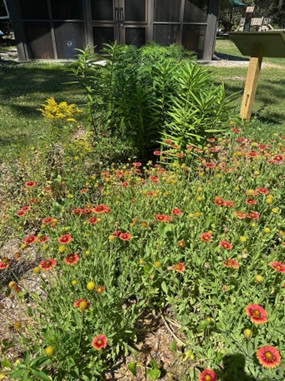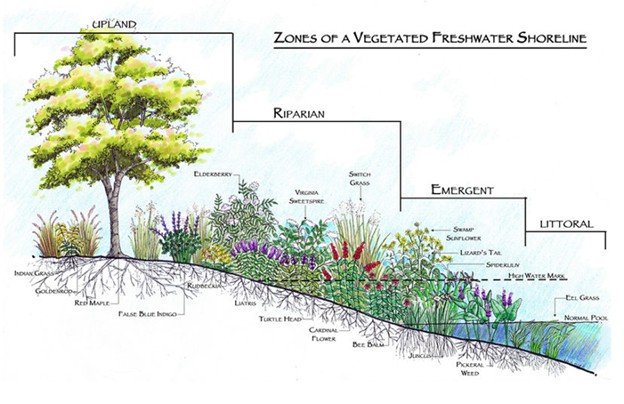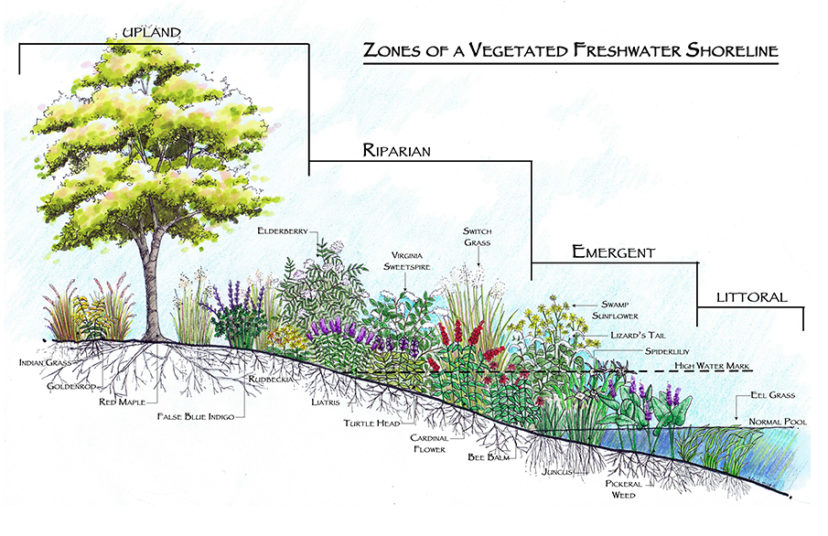Managing Stormwater with Native Plants: Natural Solutions for Healthier Waterways
By Samantha Porzelt, Lowcountry Chapter
What Is Stormwater?
After a rainstorm, water that falls onto impervious surfaces such as roofs, driveways, compacted lawns, parking lots, and roads cannot soak into the ground. Instead, it flows as stormwater runoff across the landscape. As it travels, this water collects contaminants like fertilizers, oil, trash, bacteria from pet waste, and sediment, carrying them to storm drains and ultimately to local rivers, lakes, or the ocean. Because stormwater systems typically discharge directly to waterways without treatment, unmanaged runoff is one of the leading causes of water pollution in the United States (EPA).
The consequences are twofold:
- Property damage: Large or repeated rain events can cause localized flooding and erosion.
- Water quality degradation: Pollutants in runoff can reduce oxygen in water, harm aquatic life, fuel nuisance algae blooms, and impair recreational waters.
Managing stormwater at the residential scale is a key step in reducing these impacts, and native plants are a central part of the solution.

Why Stormwater Matters
In natural landscapes like forests and wetlands, rainfall soaks into the soil. Tree roots create pathways for infiltration, and plants return water to the atmosphere through evapotranspiration. Only a small portion of rainfall runs off into streams.
By contrast, developed landscapes dominated by hard surfaces generate much higher volumes of stormwater. This increases the risk of flooding and delivers more pollutants into waterways. The result can be unhealthy ponds, degraded streams, and declining fish, birds, and other wildlife habitats.
How Native Plants Support Stormwater Management
Native trees, shrubs, grasses, and wildflowers typically have deeper and more extensive root systems than turfgrass or many non-native ornamentals. These roots help stabilize soil, reduce erosion, and create natural channels that allow stormwater to soak into the ground instead of rushing away.
In addition to improving soil structure, native plants play an essential role in keeping water clean. Their roots and associated soil microbes can intercept and filter runoff before it enters waterways. This process traps sediment, absorbs excess nutrients, and breaks down pollutants. Because native plants do not require fertilizers and pesticides, they further reduce pollution at its source.
Select native plants that fit your site’s soil moisture and sunlight conditions. Once established, they typically need little to no supplemental watering because they are adapted to local soils and climate. This helps conserve water, reduce demand on municipal supplies, and minimize excess irrigation runoff.
Stormwater Solutions That Use Native Plants
- Rain Gardens: Rain gardens are shallow, landscaped depressions planted with native perennials, grasses, and shrubs. They capture runoff from rooftops, driveways, or lawns, allowing it to infiltrate the ground. Pollutants are filtered out as water moves through the soil and root zone. Properly designed rain gardens drain within 48 hours, meaning they do not create mosquito habitat. Beyond stormwater benefits, they provide pollinator-friendly blooms and seasonal interest.
Common native plants used for rain gardens include sweetgrass (Muhlenbergia capillaris), goldenrod (Solidago sp.), aster (Symphyotrichum sp.), and American beautyberry (Callicarpa americana)

Demonstration rain garden at Pinckney Park in James Island, SC. Photo by Samantha Porzelt, Clemson Cooperative Extension
- Bioswales: Engineered vegetated channels convey stormwater while filtering pollutants. When planted with native plants, they outperform turfgrass ditches in slowing water and providing ecological value.
Common native plants used for bioswales include bluestem (Androgogon sp.), switchgrass (Panicum virgatum), rose mallow (Hibiscus moscheutos), and blue flag iris (Iris virginica)
- Stormwater Pond Buffers: In residential neighborhoods, stormwater ponds are designed to capture runoff and reduce flooding. Establishing native buffers around pond edges improves their function by stabilizing banks, filtering pollutants, and supporting habitat. Reducing mowing along the shoreline or transplanting wetland-adapted natives are both practical approaches.
Common native plants used for stormwater ponds include pickerelweed (Pontederia cordata), soft rush (Juncus effusus), whitetop sedge (Rhynchospora colorata) and yellow canna (Canna flaccida)

Photo credit: Clemson Cooperative Extension
- Riparian Buffers: Along streams, native riparian plantings reduce erosion, shade the water to keep it cool for fish, and filter pollutants. Live staking, installing dormant cuttings from native woody plants, can be a low-cost way to reestablish vegetation quickly.
Common native plants used along streams include buttonbush (Cephalanthus occidentalis), elderberry (Sambucus canadensis), and black willow (Salix nigra)
Incorporating native plants into stormwater management is an environmentally sound choice and a practical investment in cleaner water, stronger communities, and healthier landscapes.
Native plants are one of the most effective tools to reduce stormwater runoff, protect water quality, and build resilient ecosystems in our backyards.
For additional resources on managing stormwater, visit:
- Carolina Rain Garden Initiative: edu/raingarden
- Carolina Clear Program: edu/carolinaclear



